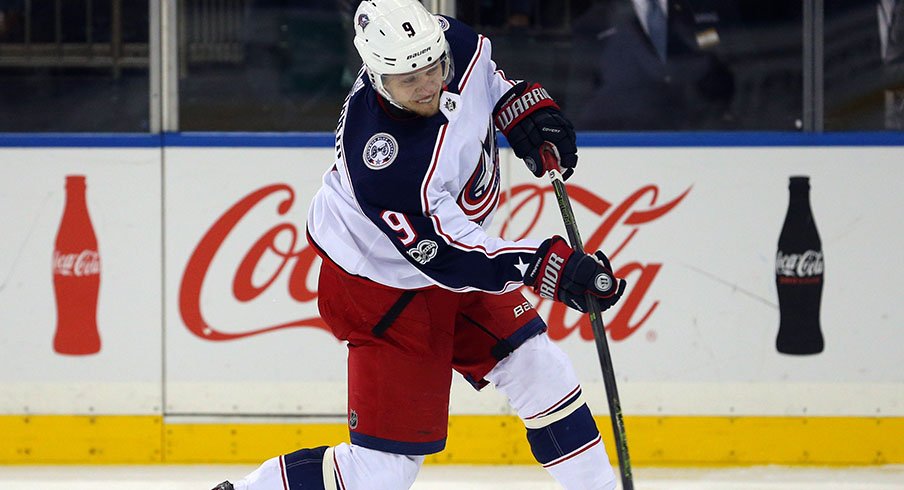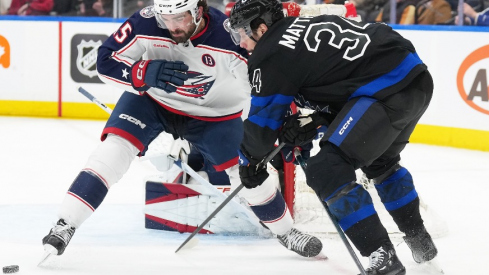On paper, they were supposed to be the Blue Jackets’ best line, until they weren’t.
The trio of Alexander Wennberg, Artemi Panarin and Cam Atkinson struggled mightily out of the gate, save for a great effort in the Blue Jackets 5-0 smashing of the New York Islanders on opening night. Shortly after that, head coach John Tortorella broke up that line, putting Nick Foligno between the two talented wingers.
Then, he put them back together.
They still didn’t click, prompting Tortorella to tell 97.1 The Fan that he was looking for more from that line. Then, he threw his lines into a blender (sidetone: a Tortorella-Vitamix endorsement deal would be so great) and the lineup smoothie that came out had Panarin, Wennberg and Atkinson all on different lines.
Blue Jackets fans have seen that movie before. A line tears it up in the preseason, generates a ton of hype, then flops and gets split up? #TBT to that Saad-Johansen-Foligno line from the 2015 preseason.
#NHL preseason: Points
— Yahoo Sports NHL (@YahooSportsNHL) October 5, 2015
Johansen CBJ 12
Foligno CBJ 9
Coyle MIN 8
Drouin TB 8
Saad CBJ 8
Stone OTT 8
Still, though, it’s frustrating to see a line flop. But hockey’s a fickle game and it’s a long season. When Cam Atkinson returned from his hip injury (and a nasty case of the flu), that top line got reunited once again. And… they’re good now?
Line combo shot rates
— Sean Tierney (@ChartingHockey) November 9, 2017
Cbj, Cgy, Stl, have strong top lines.
Ott (x2), Njd, and an Ovie line have created the most stink while together.https://t.co/EByZN5zUUa pic.twitter.com/SH8tdeDTEm
Sean Tierney’s Bad/Dull/Good/Fun quadrants are a great way to illustrate play styles. Basically, the best place to be is at the top right, in the “good” quadrant. Left-to-right measures the line’s CF/60, the rate at which they generate shot attempts, the farther right, the more active that line is. Top-to-bottom shows their CA/60, or how many shot attempts they allow. The closer to the top you are, the fewer shots you’ve allowed.
Turns out that the 9-10-13 trio is actually good.
The only lines league-wide that have been better at generating shot attempts are Nashville’s combo of Filip Forsberg, Ryan Johansen and Viktor Arvidsson (a line that’s been split up for now) and Chicago’s Brandon Saad, Jonathan Toews and Richard Panik. And there are only three lines that have been better at suppressing shots, according to the chart.
In their 109 minutes together, the Blue Jackets top line has done both generating and suppressing quite well, with a 39.33 CA/60 and a 64.05 CF/60.
Another tab on Tierney’s site shows has a full mapping-out of team line combos – even the ones that have only spent one or two games together – painting an interesting picture of the John Tortorella Vitamix Experience™.

Holy outlier, Batman!
The Dubois-Dubinsky-Calvert line that only played together for 15 minutes is the best one on the chart? Okay, so it’s a small sample size, but a CF/60 of 94.19 and a CA/60 of 27.59 is bonkers. Of course, the first chart set a minimum amount of ice time for a line to be together – a smart call given the ebbs and flows of the game – and among lines that have spent a lot of time together, the numbers say that 9-10-13 has done its part.
So, despite three straight losses, it’s a good sign to see the Jackets at the top of these 5v5 metrics. It’s a team-wide trend, too.
The Columbus GoodFun Jackets. pic.twitter.com/Rpp8oz4Njx
— Sean Tierney (@ChartingHockey) November 5, 2017
(Or, almost team-wide, ignoring Boone Jenner’s conspicuous place at the bottom of that chart…)
For those who beat the “The Jackets are actually good!” drum all last season, it may be time to update that a bit. Go ahead and add “They’re fun, too!”
Follow 1st Ohio BatteryFacebook, Twitter, Instagram and YouTube


